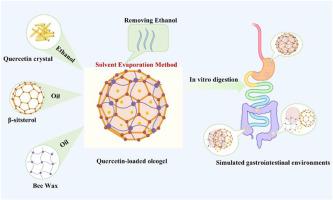Stable oleogel system for improved delivery of poorly soluble quercetin
IF 5.8
2区 农林科学
Q1 ENGINEERING, CHEMICAL
引用次数: 0
Abstract
Oleogels have emerged as promising systems for the encapsulation and sustained release of bioactive compounds. In this study, we developed a highly stable oleogel formulation by integrating two conventional techniques: the solvent evaporation method and the use of ethanol as a co-solvent. This approach enabled the successful encapsulation of bioactive compounds with poor lipophilicity and low water solubility, such as quercetin. Characterization by polarized light microscopy and X-ray diffraction revealed that ethanol played a dual role: it not only optimized the crystalline structure of the oleogel but also facilitated the formation of an amorphous solid dispersion of quercetin. This structural transformation significantly enhanced the oleogel's loading capacity and improved the bioaccessibility of compounds with low water and lipid solubility like quercetin. Furthermore, the three-dimensional network of the oleogel provided a protective matrix that reduced molecular aggregation and recrystallization, thereby enhancing the chemical stability of quercetin. In vitro simulated digestion studies demonstrated that the oleogel effectively delayed the digestion of sea buckthorn fruit oil in the gastrointestinal tract, leading to a sustained release of quercetin. This stable oleogel system presents a promising strategy for the efficient delivery of poorly soluble bioactive compounds and holds great potential for applications in the fields of nutraceuticals and functional foods.

稳定的油凝胶系统,改善递送难溶性槲皮素
油凝胶已成为一种很有前途的包封和生物活性化合物缓释系统。在本研究中,我们将溶剂蒸发法和乙醇作为共溶剂两种传统技术相结合,开发了一种高度稳定的油凝胶配方。这种方法能够成功地包封亲脂性差、水溶性低的生物活性化合物,如槲皮素。偏光显微镜和x射线衍射表征表明,乙醇具有双重作用:它不仅优化了油凝胶的晶体结构,而且促进了槲皮素无定形固体分散体的形成。这种结构转变显著增强了油凝胶的负载能力,提高了槲皮素等低水脂溶性化合物的生物可及性。此外,油凝胶的三维网络提供了一个保护基质,减少了分子聚集和重结晶,从而提高了槲皮素的化学稳定性。体外模拟消化研究表明,油凝胶有效延缓了沙棘果油在胃肠道的消化,导致槲皮素的持续释放。这种稳定的油凝胶体系为低溶性生物活性化合物的高效递送提供了一种有前景的策略,在营养保健和功能食品领域具有巨大的应用潜力。
本文章由计算机程序翻译,如有差异,请以英文原文为准。
求助全文
约1分钟内获得全文
求助全文
来源期刊

Journal of Food Engineering
工程技术-工程:化工
CiteScore
11.80
自引率
5.50%
发文量
275
审稿时长
24 days
期刊介绍:
The journal publishes original research and review papers on any subject at the interface between food and engineering, particularly those of relevance to industry, including:
Engineering properties of foods, food physics and physical chemistry; processing, measurement, control, packaging, storage and distribution; engineering aspects of the design and production of novel foods and of food service and catering; design and operation of food processes, plant and equipment; economics of food engineering, including the economics of alternative processes.
Accounts of food engineering achievements are of particular value.
 求助内容:
求助内容: 应助结果提醒方式:
应助结果提醒方式:


